上海牛津英语最新版八下unit1教案
- 格式:docx
- 大小:19.34 KB
- 文档页数:9
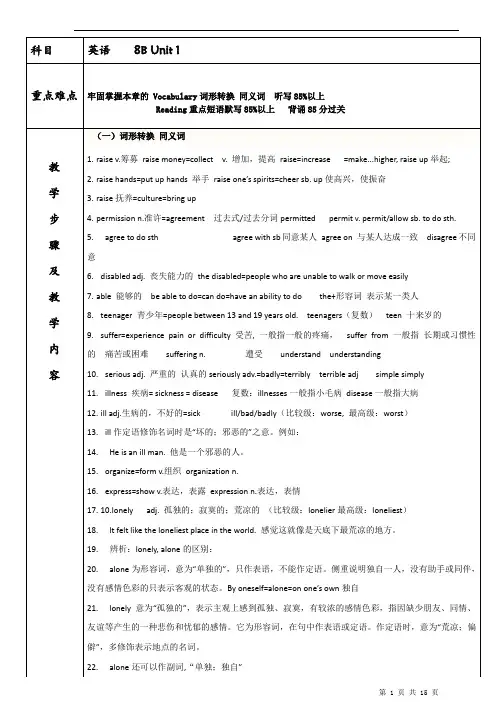
( ) 11. _______ is difficult to work out the maths problem.A.ThisB. ThatC. It( )12. We decided _______ at the end of this month.A. travelB. not start outC. to leave( )13. Let him _______ a rest. I think he must be tired after the long walk.A.hasB. haveC. to have( )14. _______the computer is a problem.A.How to useB. What to useC. Where to use9.I haven’t decided wha t (draw) for my cartoon book.10. Children under 18 years old are not allowed (drive).11. What he said made us deeply _____. (move )12. As a result of my laziness, I failed ________( finish ) my work in time.13. I am sorry ______ (not have) written you a letter at the time.14. Will you lend him a magazine _________ (read)?15. I feel tired and sleepy. Why not stop _______ (rest) for a while?语法填空Dear Mum,I’m writing this letter to talk about my worry about you. I can’t stop linking about my Dad’s death and both of us are suffering sadness. In fact, I really want to ask you (14) ____________ (not give) up being alive. All of us know that you and Dad loved each other so much. You always got up early (15) ____________ (look) after him when he was in hospital. My Dad has been away for half a year. But you still can't believe in this综合训练一、完形填空My name is Feng Guixiang. I want to tell you about the China Children and Teenagers' Fund(CCTF) and how it __1__ me.One of the CCTF's special __2__ is the Spring Bud Project. In 1989, 4.8 million children in the country, aged from seven to fourteen, were too __3__ to attend school. Eighty-three percent of them were __4__. Because of this, the CCTF launched the Spring Bud Project to help them. Since then, the project has helped millions of girls __5__ to school. It has also built a lot of schools.The very first Spring Bud class was here in Guangxi in 1989. The Spring Bud Project __6__ me to attend that class. It also rented a 7 close to the school for me. I could live in it without paying money.Before the project started, I stayed at home and helped my mother with the __8__. Going to school changed my life __9__. I learnt to read and write and do many other things.Now I __10__ a teacher at a Spring Bud school here in Guangxi. I wish to help other girls the way the Spring Bud Project helped me.1. A. hated B. helped C. accepted D. treated2. A. spirit B. difficulties C. lessons D. activities3. A. unusual B. disabled C. poor D. free4. A. girl B. students C. boys D. adults5. A. fail B. decide C. return D. walk6. A. looked for B. waited for C. lasted for D. paid for7. A. shop B. room C. car D. book8. A. housework B. teamwork C. homework D. network9. A patiently B. greatly C. carefully D. luckily10. A learn from B. care for C. talk with D. work as二、阅读理解Carly Harris is a student at University of Utah. She was travelling with her cousin in December when she saw a video on the media about a camp called Camp Moria in Greece. Then they decided to be volunteers in this camp.They tried to contact the organizer of the camp, but failed. At last, they got to the camp by themselves.Camp Moria used to be a military barrack(军营) with 700 people, but nearly 2, 000 lived there when Harris arrived in December. There, Harris’s job was to give the drenched people hot tea and dry clothes. One day, a young man in the camp told her she was very kind and thanked her very much. Harries later knew his name is Soufiane El Yassami. He is from Morocco. Many North African refugees(难民), like El Yassami, travelled across the ocean to Europe for a better life, but finally, they arrived in Lesbos as refugees, not immigrants (移民) .Harris is Mormon(摩门的), and El Yassami is Muslim(穆斯林的). They are very different in many ways. However, on Harris's last day in the camp, when El Yassami asked if he could make friends with her, she said yes. Then they became good friends and kept in touch with each other for a long time…1. What was Carly Harris doing when she saw the video about the campA. V olunteering in another refugee camp.B. Studying at University of Utah.C. Working in a social medium company.D. Travelling with her cousin.2. The underlined word "drenched" in Paragraph 4 probably means __________ in English.A. wetB. weakC. poorD. old3. What can we know about El Yassami from the passage?A. He is not Muslim.B. He thought Harris was very kind.C. He would like to work with Harris.D. He got to lesbos as an immigrant at last.4. Which of the following is true according to the passage?A. Harris had graduated from University of Utah.B. Harris succeeded in contacting the organizer of Camp Moria.C. Camp Moria should be very crowded.D. Harris didn’t want to make frien ds with el Yassami.5. In what order did the following events take place?a. El Yassami arrived in Lesbos as a refugee.b. Harris gave hot tea and dry clothes to the people in the camp.c. Harris made friends with El Yassami.d. Harris saw the Greek camp from a video on social media.e. El Yassami expressed his thanks to Harris.A. a-b-e-d-cB. a-d-b-e-cC. d-b-a-c-eD. d-a-b-c-e三、根据短文内容,从选项中选出能填入文中空白处的最佳选项,选项中有一项为多余选项。
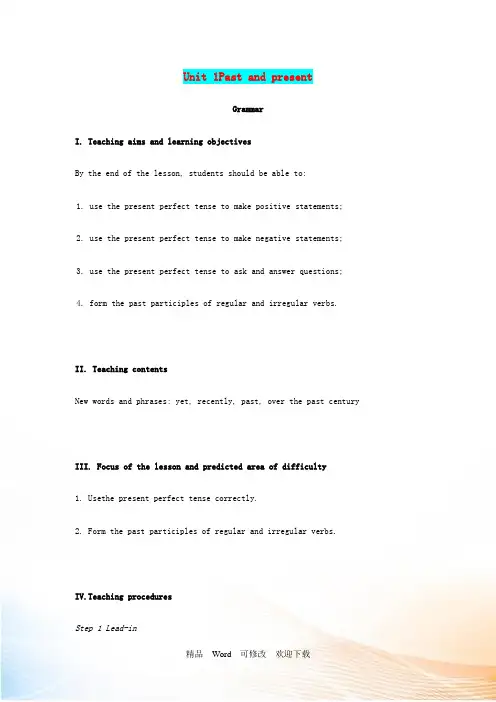
Unit 1Past and presentGrammarI. Teaching aims and learning objectivesBy the end of the lesson, students should be able to:1. use the present perfect tense to make positive statements;2. use the present perfect tense to make negative statements;3. use the present perfect tense to ask and answer questions;4. form the past participles of regular and irregular verbs.II. Teaching contentsNew words and phrases: yet, recently, past, over the past centuryIII. Focus of the lesson and predicted area of difficulty1. Usethe present perfect tense correctly.2. Form the past participles of regular and irregular verbs.IV.Teaching proceduresStep 1 Lead-in1. Free talkT: What do you know about Mr Chen and SunshineTown?【设计意图:通过口头交流,考察学生对Reading板块的掌握程度,同时引出本课时学习内容。
】Step 2 Presentation1.Structure of the present perfect tensesb + have/has + done2. When to use the present perfect tense(1) We use the present perfect tense to talk about an action that started in thepast and continues to the present.(2) We use the present perfect tense to talk about an action that happened in thepast and has a connection with the present.(3) We also use the present perfect tense to talk about how many times an actionhas happened till now.3. Matching exerciseT: Here are six sentences in the present perfect tense. Match the reasons for using the tense on the right with the sentences.4. Work out the rule(1) Present some positive statements in the present perfect tense and ask studentsto work out the rule.He has just gone home.She has already had a holiday this year.It has broken!I have seen my new English teacher.They have bought a new car.You have finished the exercise.We have seen this film before.◆We use “have + done” with pronoun s like _____, _____, _____ and _____.◆We use “has + done” with pronoun s like _____, _____ and _____.(2) Present some negative statements in the present perfect tense and ask studentsto work out the rule.sb + haven’t/have not + donehasn’t/has not(3) Present some Yes/No questions in the present perfect tense and ask studentsto work out the rule.Have/Has + sb + done(4) Present some Wh- questions in the present perfect tense and ask students towork out the rule.Wh-words + have/has + sb + done4. Time expressionsT: We can use these time expressions with the present perfect tense: already, yet, ever, never, just, recently, since and for.T: Complete the following passages and sentences with the correct forms of the verbs in the brackets.Pay attention to the time expressions.5. PairworkT: Work in pairs and talk about recent activities. Use the conversation on the screen as a model.6. CompetitionT: Form the past participles of the following verbs. Let’s see which team is the fastest.T: Try to work out the rule of form the past participles of regular verbs. Try to remember the past participles of irregular verbs.【设计意图:让学生直观感知现在完成时,引导学生从感知过渡到理解、归纳和运用,让他们在语境中逐步理解和掌握现在完成时的结构、功能及意义。
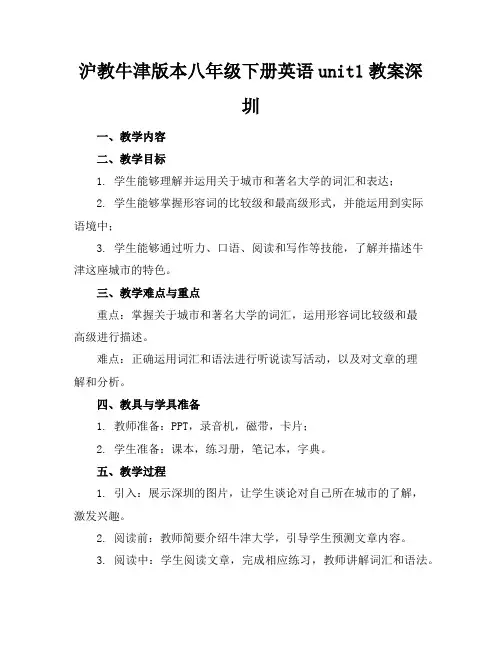
沪教牛津版本八年级下册英语unit1教案深圳一、教学内容二、教学目标1. 学生能够理解并运用关于城市和著名大学的词汇和表达;2. 学生能够掌握形容词的比较级和最高级形式,并能运用到实际语境中;3. 学生能够通过听力、口语、阅读和写作等技能,了解并描述牛津这座城市的特色。
三、教学难点与重点重点:掌握关于城市和著名大学的词汇,运用形容词比较级和最高级进行描述。
难点:正确运用词汇和语法进行听说读写活动,以及对文章的理解和分析。
四、教具与学具准备1. 教师准备:PPT,录音机,磁带,卡片;2. 学生准备:课本,练习册,笔记本,字典。
五、教学过程1. 引入:展示深圳的图片,让学生谈论对自己所在城市的了解,激发兴趣。
2. 阅读前:教师简要介绍牛津大学,引导学生预测文章内容。
3. 阅读中:学生阅读文章,完成相应练习,教师讲解词汇和语法。
4. 阅读后:学生进行小组活动,讨论文章内容,完成口头和书面任务。
5. 听力:学生听录音,完成听力练习,提高听力技巧。
6. 口语:学生进行角色扮演,模拟参观城市的情景,锻炼口语表达能力。
7. 写作:学生根据模板,写一张关于深圳的明信片。
六、板书设计2. 语法:er, est, more, most3. 句型: What's the name of the city? It's Oxford.What's the city famous for? It's famous for its university.七、作业设计1. 作业题目:Write a postcard about Shenzhen.2. 答案示例:Dear Tom,I'm visiting Shenzhen, a modern and beautiful city in China. It's famous for its technology and night view. Thecity is full of skyscrapers and parks. I especially like the Window of the World, where I can see replicas of famous landmarks from all over the world. I hope to visit it again.Best wishes,Li Ming八、课后反思及拓展延伸1. 反思:关注学生的学习情况,调整教学策略,提高教学效果。
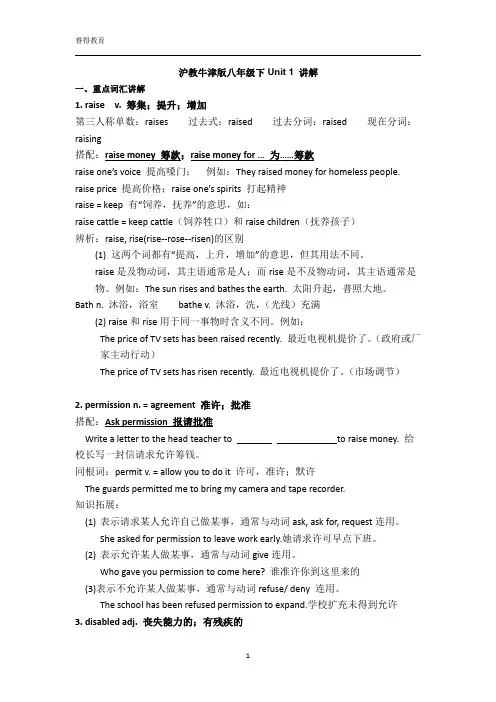
沪教牛津版八年级下Unit1讲解一、重点词汇讲解1.raise v.筹集;提升;增加第三人称单数:raises过去式:raised过去分词:raised现在分词:raising搭配:raise money筹款;raise money for…为……筹款raise one’s voice提高嗓门;例如:They raised money for homeless people. raise price提高价格;raise one’s spirits打起精神raise=keep有“饲养,抚养”的意思,如:raise cattle=keep cattle(饲养牲口)和raise children(抚养孩子)辨析:raise,rise(rise--rose--risen)的区别(1)这两个词都有“提高,上升,增加”的意思,但其用法不同。
raise是及物动词,其主语通常是人;而rise是不及物动词,其主语通常是物。
例如:The sun rises and bathes the earth.太阳升起,普照大地。
Bath n.沐浴,浴室bathe v.沐浴,洗,(光线)充满(2)raise和rise用于同一事物时含义不同。
例如:The price of TV sets has been raised recently.最近电视机提价了。
(政府或厂家主动行动)The price of TV sets has risen recently.最近电视机提价了。
(市场调节)2.permission n.=agreement准许;批准搭配:Ask permission报请批准Write a letter to the head teacher to to raise money.给校长写一封信请求允许筹钱。
同根词:permit v.=allow you to do it许可,准许;默许The guards permitted me to bring my camera and tape recorder.知识拓展:(1)表示请求某人允许自己做某事,通常与动词ask,ask for,request连用。

沪教牛津版本八年级下册英语unit1优质教案深圳一、教学内容本节课选自沪教牛津版本八年级下册英语Unit 1《Travelling》。
教学内容包括:Reading部分的“The journey to the West”以及相关词汇和语法。
二、教学目标1. 能够理解并运用本课的生词和短语,如:adventure, mountain, danger, excited等。
2. 能够运用一般过去时描述过去发生的事情。
3. 能够通过阅读文章,了解并复述《西游记》的主要情节。
三、教学难点与重点重点:一般过去时的运用,文章的理解与复述。
难点:一般过去时的正确使用,文章细节的理解。
四、教具与学具准备教具:PPT,黑板,教材。
学具:笔记本,文具。
五、教学过程1. 导入:通过展示一组旅游图片,引导学生谈论自己的旅游经历,引入本课主题。
2. 阅读前:让学生预测文章内容,激发他们的阅读兴趣。
3. 阅读中:引导学生阅读文章,完成相关练习,如填空、回答问题等,理解文章内容。
4. 阅读后:让学生复述文章,巩固所学知识。
a. 小组活动:学生分组讨论,运用一般过去时描述自己的旅游经历。
b. 例题讲解:针对一般过去时进行讲解,举例说明。
c. 随堂练习:让学生完成教材中的练习题,巩固语法知识。
六、板书设计1. 生词和短语:adventure, mountain, danger, excited等。
2. 一般过去时的结构:主语 + 动词过去式。
3. 《西游记》主要情节。
七、作业设计1. 作业题目:用一般过去时描述你最近一次的旅游经历。
答案示例:Last summer, I went to Beijing with my family. We visited the Forbidden City and climbed the Great Wall. We were all excited about the trip.2. 课后阅读:阅读教材中的其他文章,了解不同地方的旅游特色。
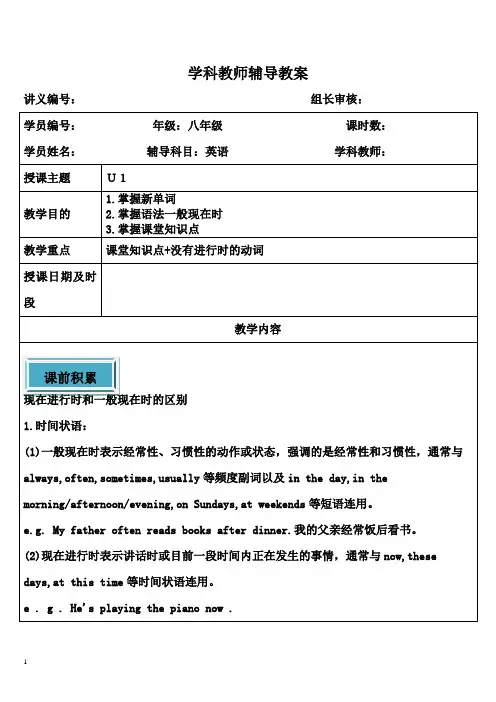
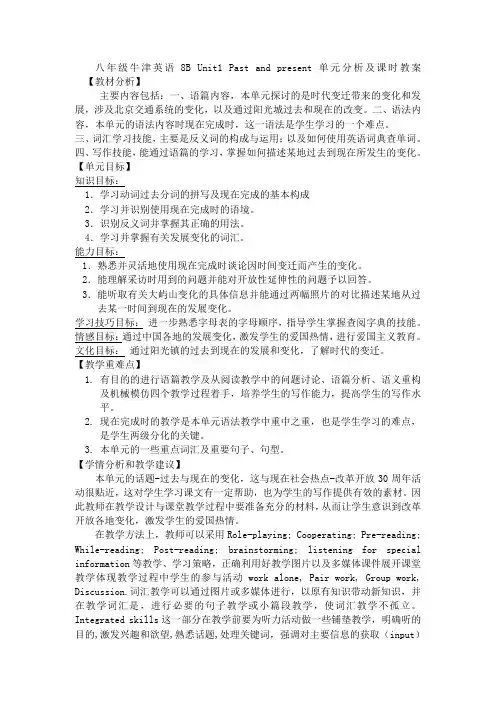
八年级牛津英语8B Unit1 Past and present 单元分析及课时教案【教材分析】主要内容包括:一、语篇内容,本单元探讨的是时代变迁带来的变化和发展,涉及北京交通系统的变化,以及通过阳光城过去和现在的改变。
二、语法内容,本单元的语法内容时现在完成时,这一语法是学生学习的一个难点。
三、词汇学习技能,主要是反义词的构成与运用;以及如何使用英语词典查单词。
四、写作技能,能通过语篇的学习,掌握如何描述某地过去到现在所发生的变化。
【单元目标】知识目标:1.学习动词过去分词的拼写及现在完成的基本构成2.学习并识别使用现在完成时的语境。
3.识别反义词并掌握其正确的用法。
4.学习并掌握有关发展变化的词汇。
能力目标:1.熟悉并灵活地使用现在完成时谈论因时间变迁而产生的变化。
2.能理解采访时用到的问题并能对开放性延伸性的问题予以回答。
3.能听取有关大屿山变化的具体信息并能通过两幅照片的对比描述某地从过去某一时间到现在的发展变化。
学习技巧目标:进一步熟悉字母表的字母顺序,指导学生掌握查阅字典的技能。
情感目标:通过中国各地的发展变化,激发学生的爱国热情,进行爱国主义教育。
文化目标:通过阳光镇的过去到现在的发展和变化,了解时代的变迁。
【教学重难点】1.有目的的进行语篇教学及从阅读教学中的问题讨论、语篇分析、语义重构及机械模仿四个教学过程着手,培养学生的写作能力,提高学生的写作水平。
2. 现在完成时的教学是本单元语法教学中重中之重,也是学生学习的难点,是学生两级分化的关键。
3. 本单元的一些重点词汇及重要句子、句型。
【学情分析和教学建议】本单元的话题-过去与现在的变化,这与现在社会热点-改革开放30周年活动很贴近,这对学生学习课文有一定帮助,也为学生的写作提供有效的素材。
因此教师在教学设计与课堂教学过程中要准备充分的材料,从而让学生意识到改革开放各地变化,激发学生的爱国热情。
在教学方法上,教师可以采用Role-playing; Cooperating; Pre-reading; While-reading; Post-reading; brainstorming; listening for special information等教学、学习策略,正确利用好教学图片以及多媒体课件展开课堂教学体现教学过程中学生的参与活动work alone, Pair work, Group work, Discussion.词汇教学可以通过图片或多媒体进行,以原有知识带动新知识,并在教学词汇是,进行必要的句子教学或小篇段教学,使词汇教学不孤立。
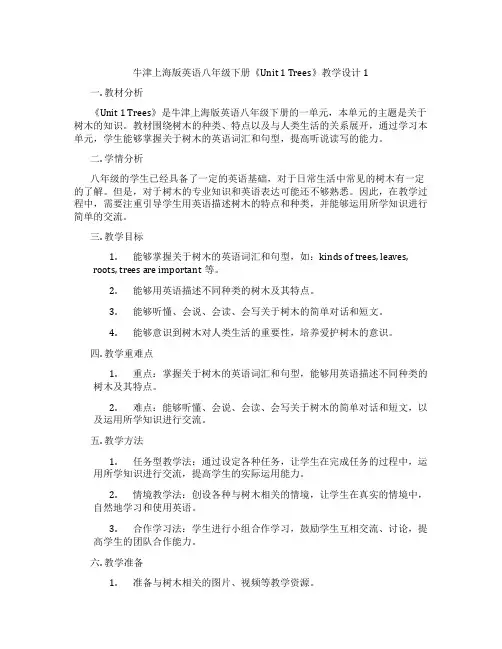
牛津上海版英语八年级下册《Unit 1 Trees》教学设计1一. 教材分析《Unit 1 Trees》是牛津上海版英语八年级下册的一单元,本单元的主题是关于树木的知识。
教材围绕树木的种类、特点以及与人类生活的关系展开,通过学习本单元,学生能够掌握关于树木的英语词汇和句型,提高听说读写的能力。
二. 学情分析八年级的学生已经具备了一定的英语基础,对于日常生活中常见的树木有一定的了解。
但是,对于树木的专业知识和英语表达可能还不够熟悉。
因此,在教学过程中,需要注重引导学生用英语描述树木的特点和种类,并能够运用所学知识进行简单的交流。
三. 教学目标1.能够掌握关于树木的英语词汇和句型,如:kinds of trees, leaves,roots, trees are important等。
2.能够用英语描述不同种类的树木及其特点。
3.能够听懂、会说、会读、会写关于树木的简单对话和短文。
4.能够意识到树木对人类生活的重要性,培养爱护树木的意识。
四. 教学重难点1.重点:掌握关于树木的英语词汇和句型,能够用英语描述不同种类的树木及其特点。
2.难点:能够听懂、会说、会读、会写关于树木的简单对话和短文,以及运用所学知识进行交流。
五. 教学方法1.任务型教学法:通过设定各种任务,让学生在完成任务的过程中,运用所学知识进行交流,提高学生的实际运用能力。
2.情境教学法:创设各种与树木相关的情境,让学生在真实的情境中,自然地学习和使用英语。
3.合作学习法:学生进行小组合作学习,鼓励学生互相交流、讨论,提高学生的团队合作能力。
六. 教学准备1.准备与树木相关的图片、视频等教学资源。
2.准备树木的英语词汇和句型卡片。
3.准备录音机、磁带等录音设备。
4.准备与树木相关的阅读材料。
七. 教学过程1.导入(5分钟)利用图片、视频等教学资源,引导学生谈论日常生活中见的到的树木,激发学生的学习兴趣。
2.呈现(10分钟)利用卡片,呈现本节课的重点词汇和句型,如:kinds of trees, leaves, roots, trees are important等。
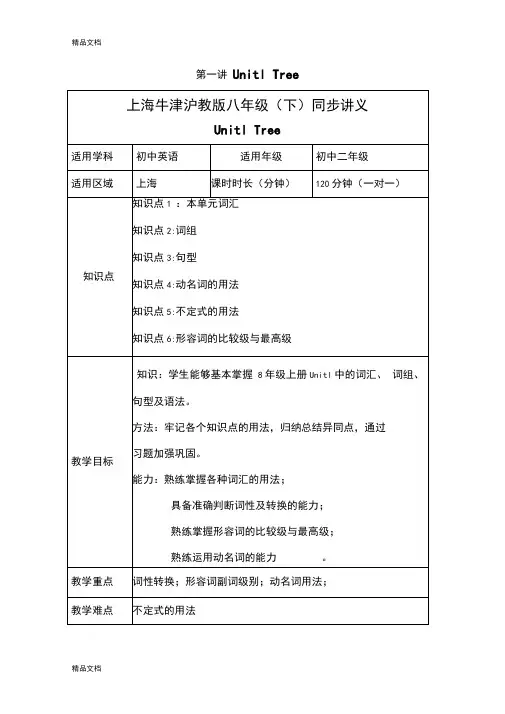
第一讲Unitl Tree教学过程一、课堂导入教师讲述一个与本节课题目有关的英文小故事,引出今日所要讲解的知识点,然后让学生简单梳理一下所涉及的问题,带着问题学习本节课的内容。
二、复习预习教师引导学生复习上节课学的重点内容,检测单词的用法,(以提问、回顾的形式进行),针对上节课的作业进行讲评、订正、答疑,并通过英文小故事导入本节课所要学习的新知识。
三、知识讲解1.知识点一:重点单词1)average[??v ?r?d?]【词性】adj.【词义】平均的【经典例句】Match the living things on the left with the average ages on the right. 把左边的生命和右边的平均年龄连线。
2)item [a2?m]【词性】n.【词义】一件物品【易混淆点】item 一件物品;项目event 活动项目【经典例句】Which of the following items come from trees?以下哪件物品时来自树?3)product [?Dr?d?kt]【词性】n.【词义】产品【易混淆点】product产品produce 生产【经典例句】This is kind of new product.这是一款新的产品。
4)fighter [fa2?(r)]【词性】n.【词义】斗士;战士【易混淆点】fight战斗fright 使惊吓【经典例句】The pollution fighters are probably scientists.抗污染战士可能是科学家。
5)fact [f?kt]【词性】n.【词义】事实【易混淆点】fact事实truth真理【经典例句】Judy is collecting some facts for a class project on pollution.Judy正在为一个关于污染的班级报告搜集一些事实。
6)scientist 务a??irst]【词性】n.【词义】科学家【易混淆点】scientist科学家science 科学【经典例句】She is interviewing Doctor Ray, a scientist about trees.她正在面试Ray博士,一位有关树木的科学家。
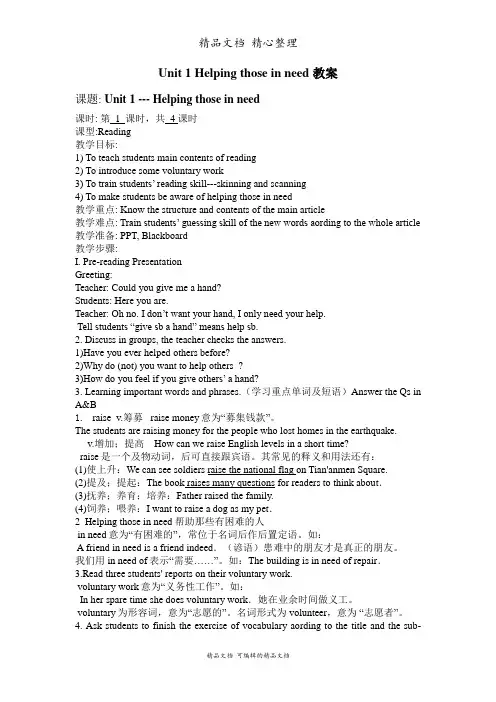
Unit 1 Helping those in need 教案课题: Unit 1 --- Helping those in need课时: 第 1 课时,共 4 课时课型:Reading教学目标:1) To teach students main contents of reading2) To introduce some voluntary work3) To train students’ reading skill---skinning and scanning4) To make students be aware of helping those in need教学重点: Know the structure and contents of the main article教学难点: Train students’ guessing skill of the new words aording to the whole article 教学准备: PPT, Blackboard教学步骤:I. Pre-reading PresentationGreeting:Teacher: Could you give me a hand?Students: Here you are.Teacher: Oh no. I don’t want your hand, I only need your help.Tell students “give sb a hand” means help sb.2. Discuss in groups, the teacher checks the answers.1)Have you ever helped others before?2)Why do (not) you want to help others ?3)How do you feel if you give others’ a hand?3. Learning important words and phrases.(学习重点单词及短语)Answer the Qs in A&B1.raise v.筹募 raise money意为“募集钱款”。
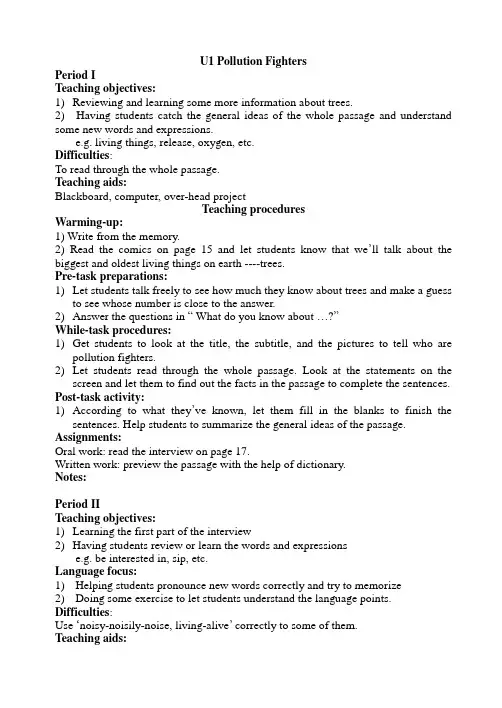
U1 Pollution FightersPeriod ITeaching objectives:1)Reviewing and learning some more information about trees.2) Having students catch the general ideas of the whole passage and understand some new words and expressions.e.g. living things, release, oxygen, etc.Difficulties:To read through the whole passage.Teaching aids:Blackboard, computer, over-head projectTeaching proceduresWarming-up:1) Write from the memory.2) Read the comics on page 15 and let students know that we’ll talk about the biggest and oldest living things on earth ----trees.Pre-task preparations:1)Let students talk freely to see how much they know about trees and make a guessto see whose number is close to the answer.2)Answer the questions in “ What do you know about …?”While-task procedures:1)Get students to look at the title, the subtitle, and the pictures to tell who arepollution fighters.2)Let students read through the whole passage. Look at the statements on thescreen and let them to find out the facts in the passage to complete the sentences. Post-task activity:1)According to what they’ve known, let them fill in the blanks to finish thesentences. Help students to summarize the general ideas of the passage. Assignments:Oral work: read the interview on page 17.Written work: preview the passage with the help of dictionary.Notes:Period IITeaching objectives:1)Learning the first part of the interview2)Having students review or learn the words and expressionse.g. be interested in, sip, etc.Language focus:1) Helping students pronounce new words correctly and try to memorize2) Doing some exercise to let students understand the language points. Difficulties:Use ‘noisy-noisily-noise, living-alive’ correctly to some of them.Teaching aids:Blackboard, computer, over-head projectTeaching proceduresWarming-up:Complete the statements to see how much they remember the information about trees.Pre-task preparations:Ask students the meanings of the new words. They can choose one of the answers. Then learn to read.While-task procedures:1) Review and introduce the words and expressions.2) Do some exercise to help students understand how to use the language points correctly.Post-task activity:Do some exercise by themselves.Assignments:Oral work: read the textWritten work: review the new words and expressions.Notes:默写时间太长以至于后面知识点来不及讲,减少学生做笔记时间,通过练习让学生理解知识点并且运用。
Past and present 教学目标1.学习现在完成时的时间副词和时间短语。
2.能在语境中运用现在完成时。
重点现在完成时与一般过去时在时间副词用法区别。
难点现在完成时与一般过去时在时间副词用法区别。
教法及教具教学过程教学内容个案调整教师主导活动学生主体活动Step1 Lead-inThe teacher can have a free talk with the students.e.g. You have known something about Mr. Chen.Could you tell me anything about Mr. Chen?Step2 Pre-taskRecently we have already known a little a bout Sunshine Town.I have never been there before. Have you ever been there?S1: No, I haven’t been there yet.T: Mr. Chen was born there. He has known it since he was veryyou ng. He has known it for a long time.Step3 While-t a skTask 11) Tell the students that we can use adverbs of time with thepresent perfect t ense, such as already, ever, for, just,never, since and yet.2) Some more examples:I have just seen Millie on the playground.Has Millie called yet? No, she hasn’t.I have not hea rd from Millie yet.I have done my homework alr eady.I have never read theRead ,write andremember.novel. …Step4 ExercisesA.选择填空 (See PPT)Have you done your homework ______? (for, just, yet)I have _______ __been to Chengdu. (eve r, never, yet)He has _______ washed the dis hes. (already, ever, for) He has worked there _______ he left school. (already, just, since)Have you cleaned your room _______? (for, just, yet)She has known Sam _____ nine years. (for, never, since) Have you ______ ridden a horse? (ever, for, yet)They have ______ arrived. (ever, just, yet)We have not completed the project _______. (already, for, yet)B. for or since1. We have lived here ____ 1990.2. How long have you studied here? ___ 5 years.3. The boy has had a bad cold _____ last night.4. Mr. Huang has kept the books ______ a week ago.5. I have taught in the school _____ I came here.6. We have been friends ____ a long time.总结: for +段时间since +点时间 (过去时间)since +句子(一般过去时态的句子)C.句型转换1. The boy has already gone home. (一般疑问句)2. The girl has already given it to me. (否定句)3.They have ever visited the Hainan Island before .(否定句)1.现在完成时)肯定句变为否定句的基本方法:2.(现在完成时)肯定句变为一般疑问句的基本方法:3.注意点:just、already、yet之间的关系及各自适应的句型板书设计教学札记。
Unit 1 Past and Present (第6-10课时)Unit 1 the 6th periodContent: Reading (二)Teaching aims:1 To grasp some useful expressions2 To retell the main idea of the text3 To understand the use of some words through the exercises.Important and difficult points:Alone & lonelyTeaching proceduresStep 1: review the first part of the texta) important phrasesb) ask and answer according to the textc) recite some part of the textStep 2 learn the rest of the text1) let students ask questions and find answers together.2) useful expressions.1 miss 想念 eg: I miss my old friends very much.错过 eg: He missed the early bus this morning.(miss doing --)2 pleasant :指环境,地方,行程的舒适愉快。
多用于修饰事物。
Eg: The weather is usually pleasant here in May . The trip is pleasant.Pleased :指感到愉快。
通常描述人。
Be pleased with--Eg: I’m pleased with your work. The teacher is pleased with us.同根词---pleasure. With pleasure /It’s my pleasure.3 take off 起飞 The plane has taken off. /脱下 Take off your coat. It’s hot here.4 safely adv. land safely safe adj. The place is safe . safety n. Take him to safety.5 way 1)方面,方式,方法。
[八年级英语]初中英语牛津上海版八年级下册第一单元拓展课教学设计More Practice广州七中李静东一、教材分析:1.Input-based,本课时Part A为泛听,Part B为任务阅读。
可根据学生实际情况选择进行。
二、教学目标:1、知识目标:通过听力与阅读训练,增补与本单元主题相关的材料,帮助学生了解更多与该话题“success and successful people”相关的信息。
2、能力目标:能就课文内容进行问答;能复述课文大意,描述不同类型的成功人士;能背诵课文中的重点句型或句子;能读懂有关成功人士的报道,了解不同类型的成功人士;学会捕捉不同人对“成功人士”的不同理解;能清晰知道成功的定义。
3、情感目标:进一步引导学生探究如何才会“成功”,引导学生继续寻找成功人士的足迹和通向成功的途径。
让学生明白做好自己的事情,努力工作、学习,付出比常人更多的努力,及善于捕捉机会,才能实现自己的理想和抱负。
三.重点与难点:1. 引导学生了解更多不寻常的success and successful people,开阔视野。
2. 指导学生阅读这种人物传记式的文章,通过如实回答问题得出答案或者结论。
3. 指导学生运用一些阅读学习策略,培养阅读微技能,如:略读、寻读,找出关键信息等。
4. 通过阅读激发学生对科学探究的兴趣;让学生了解“成功”来自不断的探索和努力的工作,了解历史人物对科学发明和公共服务的贡献。
四.教学对象分析: 学生对success and successful people 的话题比较感兴趣。
但是由于所处环境和生活经历的限制,该话题与学生又有一定的距离(可能仅在谈论自己所接触或了解的人或事)。
因此教师在教学中应该尽量多地把话题与现实生活联系起来,例如让学生多关心时事政治、通过电视或上网,谈论success and successful people.五.教学设计方法与依据:阅读是学习语言过程中最重要而且关键的一个环节,是一个有大量语言输入的过程,而输入的效果如何又往往与情景的设计、已知知识的铺垫和有效的引导有很大关系。
Unit1period 1教学内容:Vocabulary语言知识目标:学会以下词汇:raise permission disabled teenager offer sufferillness organize express pain lonely friendship difficulty joy hurt (hurt, hurt)( courage spirits pay (paid, paid) community in need voluntary work ask permission suffer from raise one‘s spirits in order to语言技能目标:1、学会用音标记单词2、学会单词的构词法和分析单词的规律学习策略:1.游戏教学(大小声)2.竞赛(首字母抢答。
念中说英,念英说中)情感态度:学会用赏识的眼光去鼓励每位学生说英语。
Step1 : 复习英标Step2 :单词教授raise permission…Game : high and low./Simon said→silent I said →say quicklyListen to the tape .Step3 : 复习巩固Read togetherRead in groupSay English/Say ChineseStep 4: 拓展competition (首字母抢答)Step 5 : Homework for today1 、朗读单词2、抄写单词→预习课文(译P3)period 2教学内容:Reading教学目标:语言知识:初步了解篇章的结构语言技能:根据上下文语境猜测词义。
初步理解文章脉络了解三篇汇报学习策略:运用略读策略,了解大致内容情感态度:树立服务他人,保护弱者的意识。
教学重点:根据上下文语境猜测词义。
教学难点:通过初步阅读了解文章大意教学过程:step1:导入1.学生观察PPT展现的图片-爱心,展开议论。
老师提问:1Have you ever help others before?2Why do you help others?3How do you feel when you give others a hand?give sb a hand= help sb2.Can you guess what we will learn in this unit? --voluntary work3.What do you know about…?pictures :a helping disabled people b. c. d. (理解图片,理解短语意思进行配对)step2:新课展现1.(看图片,作者的名字和三篇汇报的第一句话。
完成阅读前)1Mark 2 Betty 3Annie2.初步阅读三篇汇报完成C1 (让学生猜词意识)先让学生理解句子的意思再有学生说出斜体单词的意思最后选出真确答案。
完成后让全班同学读一遍。
完成C2 (先对给出的短语解释一遍再来理解短文意思)先核对答案再朗读一遍。
step3: 听一遍课文录音。
Homework:默写单词短语熟读文章period 3&4教学内容:Reading语言知识:理解主阅读篇章的结构。
语言技能:通过进一步阅读,理解三篇汇报的内容学习策略:通过细读。
了解主篇章的细节信息。
情感态度:学会如何在实际中帮助别人。
教学重难点:通过进一步阅读,理解三篇汇报内容教学过程:step1 导入Read the words togetherRead the text togetherHave a dictationstep2 While- readingFirst- report1.学生阅读第一篇汇报的第一段,回答下列问题Where did Betty do voluntary work?What is wrong with the children there?What did Betty and other volunteers do for the children?翻译句子板书或展示重点短语2.学生阅读第二和第三段汇报的第一段,分别完成有关Mark 和Annie 所参与的志愿服务活动表格。
(PPT)翻译句子板书或展现重点短语3.完成D1,核对答案。
step3全班朗读以下短语offer to do sth 主动提出做某事in hospital 住院in the hospital 在医院里continue to do sth 继续做某事(另一件事情) continue doing sth 继续做原来的事have difficulty in doing sth /with sth 在某事上有困难do voluntary workduring one’s holida yin hospitalsuffer froma picture ofnear one’s hometake photo ofuse …forin an accidentraise one’s spiritsexpress one’s feelingteach sb to do sthtell storiesHomework:抄写短语画出三篇汇报的思维导图period5教学目标:语言知识:深入理解文章了解dis, un-等前缀及其含义语言技能:通过进一步阅读,掌握主篇章思维关键信息学习策略掌握通过前缀猜测单词含义的策略。
教学重难点:通过进一步阅读,掌握主篇章的关键信息。
了解主篇章基本信息的基础上,发表自己的观点并陈述理由。
step1:导入请生朗读或背诵课文教师板书单词disagree disappear dishonest dislike unimportant unlike uninteresting unnecessary要求学生猜测这些单词的意识。
老师归纳:un dis是前缀,用来表示否定意思。
其他常见的表示否定的前缀还有in im il ir non 等可以通过前缀等构词法来记忆单词。
step2:回顾主篇章内容,检查回家作业全班齐读主篇章完成表格作业大展现:思维导图三篇汇报的归纳Homework利用思维导图背诵课文。
period 6&7教学内容:Grammar教学目标:语言知识:1、掌握动词不定式的结构2、掌握动词不定式作宾语,宾语补足语和目的状语的用法。
3、掌握不带To的动词不定式用法。
语言技巧:能够在具体的语境中正确使用动词不定式。
学习策略:主动探究,善于发现语言的规律并能运用规律举一反三。
教学重点:掌握动词不定式作宾语,宾语补足语和目的状语的用法。
教学难点:区别带to 的动词不定式和不带to 的动词不定式用法。
教学过程:step1:导入P7例句学生归纳老师归纳:offer和want 后面所跟的to do 和to pain 被称为动词不定式。
动词不定式在句子中可以充当除谓语以外几乎所有的句子成分。
动词不定式的基本结构:to+动词原形step2:学习动词不定式作宾语的用法。
展现句子:1.Three teenagers offered...2.She wanted to paint…3.My mother and I will continue to visit Viven4.I wanted to help children like Tim and raise their spirits.5.I will continue to do voluntary work in the future.学生归纳:在句子中,动词不定式作谓语动词的宾语。
动词不定式作宾语的基本结构:动词+带to 的动词不定式,并归纳后常跟动词不定式的动词。
考察学生是否用动词不定式来回答主阅读篇章的相关问题。
Who did Betty decide to help?What did Cindy want to do?Who will Mark continue to visit?Who did Annie offer to help?What will Annie continue to do in the future?讲解things to remember 选用疑问词how what when where when 或who 完成练习。
I will tell you _____ to beginI’m sure you’ll remember ___ to sayI know ___ to get there.I don’t know ___ to ask for help.完成练习Astep3学习动词不定式作宾语补足语的用法。
例句-归纳动词不定式宾语补足语的基本结构:动词+宾语+带to 的动词不定式。
教师帮助学生总结后面可跟动词不定式作宾语补足语的动词:advise allow ask encourage expect order teach tell want warn …完成中译英练习(PPT)归纳动词不定式的否定形式是在动词不定式前直接加not .not to dosth.step4 学习不带to 的动词不定式用法(方法一样)step5 学习动词不定式作目的状语的用法。
看例句-归纳在句子中,动词不定式to paint 和help 分别是used a brush 和went to the hospital 的目的,作目的状语。
教师归纳:对作目的状语的动词不定式提问时,应用why . 如why did Cindy use a brush? why did they go to the hospital?完成练习CHWPPT习题Book B。